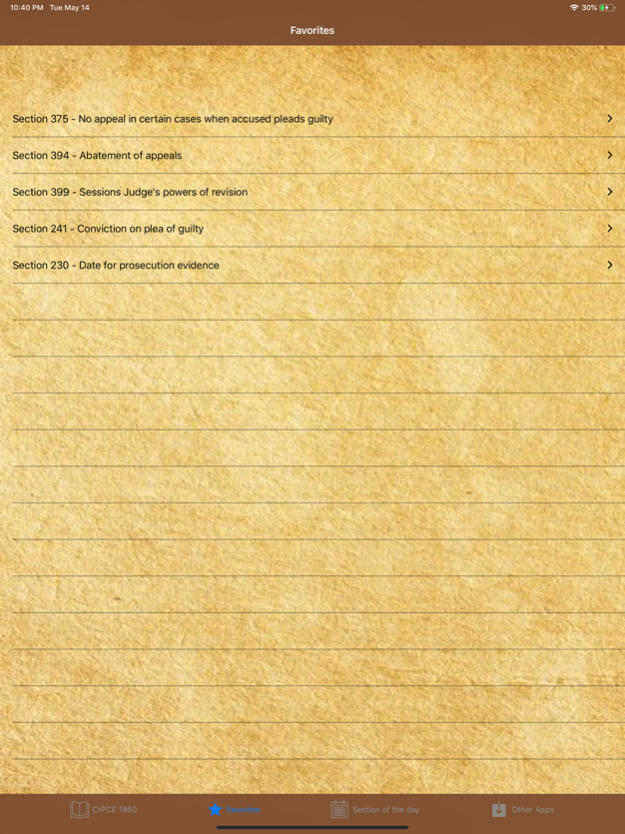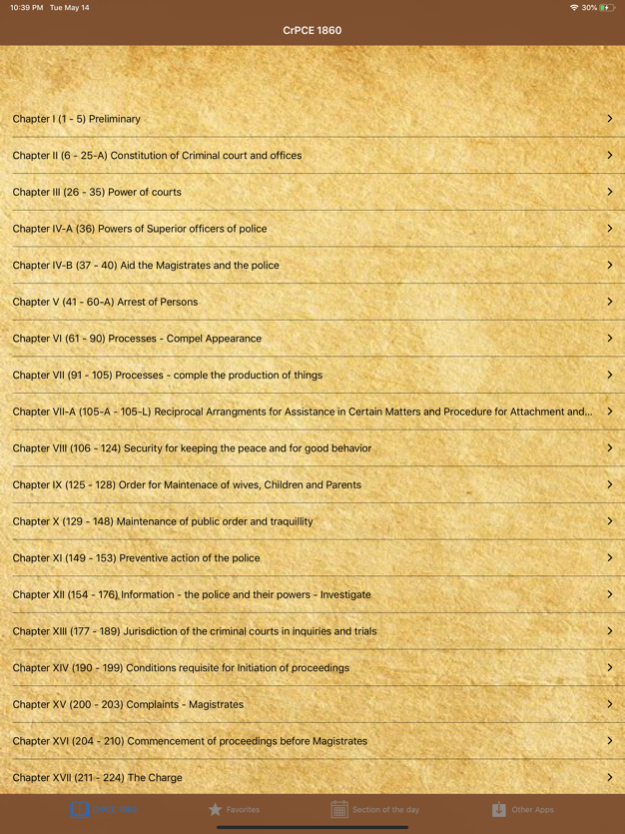CrPC 1973 in English 1.6.0
Continue to app
Free Version
Publisher Description
The Code of Criminal Procedure (CrPC ) is the main legislation on the procedure for administration of substantive criminal law in India. It was enacted in 1973 and came into force on 1 April 1974.[2] It provides the machinery for the investigation of crime, apprehension of suspected criminals, the collection of evidence, determination of guilt or innocence of the accused person and the determination of punishment of the guilty. Additionally, it also deals with public nuisance, prevention of offenses and maintenance of wife, child, and parents.
At present, the Act contains 484 Sections, 2 Schedules, and 56 Forms. The Sections are divided into 37 Chapters.
History
In medieval India, subsequent to the conquest by the Muslims, the Mohammedan Criminal Law came into prevalence. The British rulers passed the Regulating Act of 1773 under which a Supreme Court was established in Calcutta and later on at Madras and in Bombay. The Supreme Court was to apply British procedural law while deciding the cases of the Crown’s subjects. After the Rebellion of 1857, the crown took over the administration in India. The Criminal Procedure Code, 1861 was passed by the British parliament. The 1861 code continued after independence and was amended in 1969. It was finally replaced in 1972.
Classification of Offences under the Code
Cognizable and Non-cognizable Offences
Main article: Cognizable offence
Cognizable offences are those offences for which a police officer may arrest without court mandated warrant in accordance with the first schedule of the code. For non-cognizable cases the police officer may arrest only after being duly authorized by a warrant. Non-cognizable offences are, generally, relatively less serious offences than cognizable ones. Cognizable Offences reported under section 154 Cr.P.C while Non-Cognizable Offences reported under section 155 Cr.P.C. For Non-Cognizable Offences the Magistrate empowered to take cognizance under section 190 Cr.P.C. Under section 156(3) Cr.P.C the Magistrate is competent to direct the police to register the case, investigate the same and submit the challan/report for cancellation. (2003 P.Cr.L.J.1282)
Summons-Case and Warrant-Case
Under Section 204 of the code, a Magistrate taking cognizance of an offence is to issue summons for the attendance of the accused if the case is a summons case. If the case appears to be a warrant case, he may issue a warrant or summons, as he sees fit. Section 2(w) of the Code defines summons-case as, a case relating to an Offence, and not being a warrant-case. Section 2(x) of the Code defines warrant-case as, a case relating to an Offence punishable with death, imprisonment for life or imprisonment for a term exceeding two years.
May 10, 2023
Version 1.6.0
Bug fixes and improvements
About CrPC 1973 in English
CrPC 1973 in English is a free app for iOS published in the Kids list of apps, part of Education.
The company that develops CrPC 1973 in English is Mohit Agarwal. The latest version released by its developer is 1.6.0.
To install CrPC 1973 in English on your iOS device, just click the green Continue To App button above to start the installation process. The app is listed on our website since 2023-05-10 and was downloaded 10 times. We have already checked if the download link is safe, however for your own protection we recommend that you scan the downloaded app with your antivirus. Your antivirus may detect the CrPC 1973 in English as malware if the download link is broken.
How to install CrPC 1973 in English on your iOS device:
- Click on the Continue To App button on our website. This will redirect you to the App Store.
- Once the CrPC 1973 in English is shown in the iTunes listing of your iOS device, you can start its download and installation. Tap on the GET button to the right of the app to start downloading it.
- If you are not logged-in the iOS appstore app, you'll be prompted for your your Apple ID and/or password.
- After CrPC 1973 in English is downloaded, you'll see an INSTALL button to the right. Tap on it to start the actual installation of the iOS app.
- Once installation is finished you can tap on the OPEN button to start it. Its icon will also be added to your device home screen.



